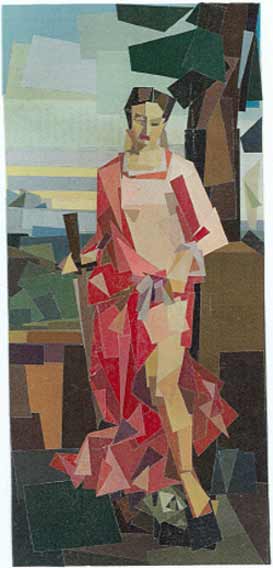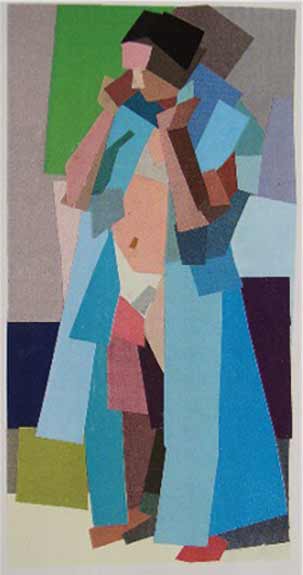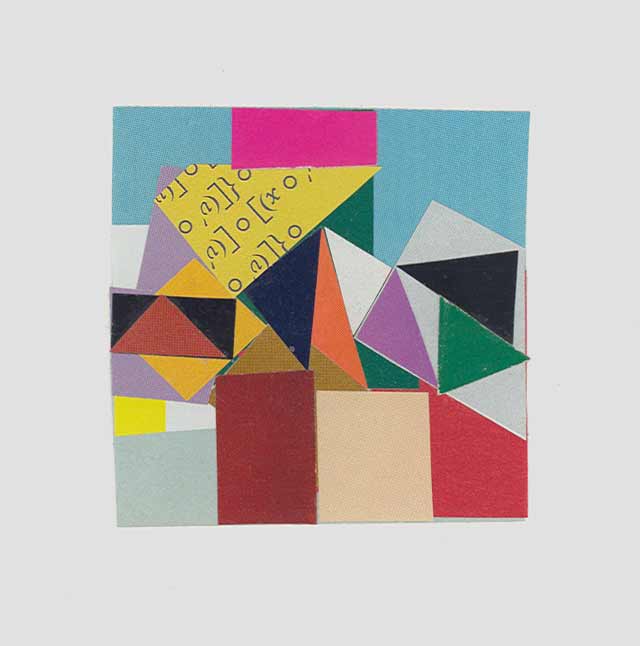
Judith with the head of Holofernes (after Giorgione), 2005 7 1/4 x 3 1/2 inches Collage
Color not based on theory but on the artist’s love of color. This will be in the work if the mind does not get in the way. Be aware of the whole painting. Look at no color without looking at another. Every color needs to relate to every other color. Which one is darker, which lighter. Keep in the mind the colors most nameable. Keep the number of these small; yellow, orange, red, purple, blue, green, white and black. Be aware of going towards or away from these. OK, one minute color theory; draw a circle and evenly place those colors around the circle, often called a wheel. On my color wheel white goes between green and yellow and black between red and purple. Colors on the opposite side of the circle are opposite colors; yellow and purple, orange and blue, red and green, white and black. To quickly get away from a color mix it with the opposite color. Think value from white to black. Yellow would be closer to white. A dark green or alizarin crimson would be closer to black. Think in this wide range. Transparent colors may need to be mixed with other darks and even black. These dark colors, used as a tint with white, create a color closer to white. Travel between these two extremes. Instead of always cleaning the brush transform whatever is on the brush toward a nameable color by adding that color or the color that when mixed becomes that color or away from that color by mixing that color’s opposite. And at the same time be aware if you are going darker or lighter. To go lighter and keep the color add white, to go lighter while changing colors add whichever color is lighter and takes you closer to the desired color. To make a bigger jump between colors, as you go lighter or darker mix in a color that goes away from the adjacent nameable color. Keep away from just adding white or black to make more surprising color. Do not think too much. Better just to enjoy the color. Do whatever you need to do to keep excited. Play, do not work. Play is the most productive work. Buying any color that excites is not a bad idea but a pretty color in itself is only a pretty color. With some basic colors you can get an unlimited amount of exciting colors when they are mixed and juxtaposed. Work in a close range then work the colors away and back again. Be aware of the dark and light masses. Group both lights and darks to make a light complex and both darks and lights to make a dark complex within the composition.
Paint parallel to nature. Be natural. Do not try too hard to match colors. This takes your eye off the larger picture.

Collage
Paint with color-shapes. One color-shape followed by another. Paint instinctively, reacting without rejecting. If not looking at nature then having looked at nature. Do not fall in love with any part. Always think of the whole. Stop at the thought of stopping.
Use a straight edge to make an unconscious line appear conscious. Nature is beautiful because it is not self-conscious. The beauty of things comes greatly from never having become accustomed to that thing, that relationship. It is what keeps things always fresh, always surprising, it is that the mind has never been able to completely name the thing.
Do not make a picture of a landscape, create a landscape.

Collage
Describe form with at least two lines in drawing, and with two colors in painting. It is placing forms in space by defining limits. A third color to describe the journey between these. Every color needs to correspond to another to build form.
Painting is very simple. Anyone can fill an area with paint but to relate everything in a complex journey without resulting in chaos takes a lifetime to master. It is amazing how unpleasant paint can become, just as some sound can be painful but this usually takes a lot of conscious thinking which we are not going to do. Similar to how sound can be noise or music the same sounds, the same paint, can be pleasurable in the right context.
Composition = a composite.





This is breathtaking. I definitely want to read more from Ken if that’s possible. I’ve heard a lot about Ken, have been following his work and hope to take a class with him at some point. I would love to take a color class with him! When I saw your Certosa photo of him putting pottery shards together in a color class it was most intriguing and I wanted to know more. Thanks for posting this, I’ve read it a couple times and will keep it close by…this is the way I want to hear about color. You are so right most writings, teachings on color are pretty dreadful, they certainly lack the passion Ken clearly has for it. Lots of great statements in here but for me the best line ever…”Love colors as writers love words. It is the love that comes through when the mind gets out of the way. Don’t think too much.”
Thanks Ann and Austin for such thoughtful comments. It isn’t easy to respond to the many ideas that Ken presents here but you both went to the heart of the matter.
Despite how much I like what he says, I’m not sure I could always follow his advice. Perhaps because I lean more towards the kind of writer who pulls his hair out and curses and bangs his hands on the keyboard that some particular grouping of words sounds so idiotic!
Many times I feel that way with color and painting, that it is less play than a agonizing struggle to capture the fleeting moment, trying to “get” something seemingly impossible. Yet, other painters, like Corot, get it dead on. But it is wonderful paradox that the more you try to copy nature the less real and “off” it tends to look but once you get the bigger, more abstract structure of light and form right and gives the painting feeling of rightness – from what the painting needs. It is in this moment, when you loose yourself in this process that the color can really transcend the arbitrary (like you see in colored drawing or more decorative approaches) and start to take on real meaning in the painting in terms of how the color relates to the whole.
For me, this starts to feel like loving colors and not thinking too much. I wish I could get there more often.
Thanks for this. Rather Zarathustra on color. You can always tell a good teacher by the absence of pedantry. As for me, getting grey was a turning point in my color journey, i.e. mixing black w/ a transparent yellow. The possibility of all those gentle modulations was an epiphany … or love at first sight. That seems to be the secret: you have to fall in love first. It was a struggle for me as an autodidact, to find my color, to fall in love. But that begs a question. How do non-painters ever get it? Especially in this age of diminishing connoisseur-ship, when, as Mr. Kewley points out, standard art-education is joke. I guess the patron’s reasons don’t matter so long as they’re patrons.
On another note, I’ve heard it said, and observed it in nature, that an particular animal species’ intelligence can be judged by the amount of time its young spend in play. Ex post facto maybe. But I like to believe they’re intelligent because they play.
Thanks for great paintings and an interesting article!
What a great attitude Ken Kewley has towards the making of a painting… There is so much in this interview that could be discussed. I have been reading choice parts of this interview just to kick start my day of painting.
Thank you Larry for the Interview and a big thanks to Ken Kewley for his heart felt words.
What a generous article. Thanks to Ken and Larry.
I really was interested to read what he said about painting the model-
“When painting the model, treat each part (do not name the parts) as something separate and then compose the parts into a whole. Into a composition. Use as few shapes as possible, do not think human.”
I’ve always marveled at how Ken finds surprising shapes and marks and angles in his figures, and this gave me a clue as to how that happens. Composing separate pieces as opposed to constructing a human figure.
Hi Larry and Mr Kewly
Wish I had been able post this sooner – Great article. These are great thoughts – perhaps too many all at once. It’s like trying to read Robert Henri’s The Art Spirit in one sitting. That’s in part what took me so long – trying to give the ideas the time they need. Mr. Kewly has said so many useful things in this grouping. Some of which as artists we may know but we would be wise to revisit and others which are really profound and new. I love the idea that we need less in the paintings and that so many paintings are ruined by having said too much. I am disappointed that when I’m in Philadelphia for Stuart Shils workshop, Mr. Kewly’s talk won’t coincide with that. I’ll have to keep an eye out for any talks that he gives in NYC.
What a wonderful article – thank you. Being from Australia, I have not heard of Ken Kewly. How sad is that? Now I have discovered his wonderful abstracts, so will my students. He speaks to my heart and has managed to put into these few pages – and so succinctly- much of what I have been trying to teach my students all year (and yes, I am amazed at how beautiful paint can end up so ugly!) Being predominantly a landscape painter, his words”Do not make a picture of a landscape, create a landscape.” were particularly resonant, and “to relate everything in a complex journey without resulting in chaos takes a lifetime to master” is what keeps us all, I imagine, going. Nothing challenges, engages and rewards so much as painting.
And I will take note: “If you try too hard it will show up in the work as an unpleasant element. I do not like to see artist suffering”. Neither do I, nor do I like to experience of suffering myself, but it happens…after this, I will remember the joy more!
Ken.
Thank you so much for your words of comfort and clarity. Just pulled myself out of a hole and am grateful to be painting without that pit in my stomach. That hard time was a great learning time because I made mud. Then I realized it was actually pulling out of a process that wasn’t true for me and I’ve moved forward…clearer and more truthful. Love what you said about not making a picture of something but making something. Thank you for the wisdom.
all best.
Cynthia Wick
“Rinsing the brush can be avoided by transforming whatever is on the brush toward a nameable color by adding that color or the color that when mix becomes that color or away from that color by mixing that color’s opposite.”
Um, why am I the only one confused???
“Group both lights and darks to make a light complex and both darks and lights to make a dark complex within the composition.” “Composition = a composite.”
Can someone loan him a dictionary???
“Do not make a picture of a landscape, create a landscape. Every color needs to correspond to another, to others, and to the whole. The same sounds, the same paint, can be pleasurable in the right context.”
Genius use of cliches…
“Most things can not be separated. This includes color, form and composition.”
Oh god… Please stop writing Mr. Cruelly
As a painter who is primarily concerned with colour, I found this article very interesting and very helpful. It is also beautiful to read, as Ken writes so eloquently about his art and painting in general.
love this article! a lot of great observations. would love to share this with students.
what an amazing and inspiring read! thanks for sharing! this whole thing is quotable.
i wish i could tell you how helpful those observations are. i’ve never heard anyone get to the heart of what i’ve wondered about for so long. my sincerest appreciation for everyone’s effort with this as the information in it will be indispensable to me and my practice.
I’m very happy this was so helpful to you.
Ken Kewley’s article on color (I am new to this blog) interested me greatly. Do you realize that artists are not often asked specifically about color: how they see it, use it, create it etc. in interviews. …..Kewley’s remarks are most helpful to me in that sense. And……. what about the great, great Braque Atelier paintings, beginning in the late l920s and up through the 1950s…sheer poetry. I feel that Braque has been forgotten, but I look all the time at the studio paintings from those years and am enthralled with their beauty. John Gage’s Color and Culture chapter on painters and
their palettes is a frequent reference for me, as is Nicholas Watkins book on Bonnard’s palette and
his use of color.
Just reading my almost daily page or so of this beautiful essay, I believe it will become a classic – for working artists – in its way, like gombrich on art history or Barry Nemett on art appreciation.
First, great site newly brought to my attention. Bookmarked.
Kewley’s work with color reminds me of process and method in Howard Stern’s book “How to see color and paint it.” It is the best book about painting. Essentially it uses spectrum color theory wherein you mix clean color complement colors, find the neutral grey between them and all the variations from the warm to the cool side. For instance blue violet on the color wheel is pigment ultramarine, some alizarin and touch of white. Opposite on the wheel is yellow orange with pigment cad orange and cad yellow pale. Take 70% of each and mix together for your grey. From the grey you can add white and make incredible variations.
This Blog is engaging, thoughtful, practical,…like finding a friend. I use it to encourage students, add greater depth of information where I lack it, and see powerful work. Ken Kewley’s notes are equally enlightening and empathetic.
He is very intriguing. It seems to have a very extensively complex yet emotional understanding of color and how certain colors can spark specific feelings in the art viewer. I would actually love to see more of his work.
Very inspiring post! Thank you.